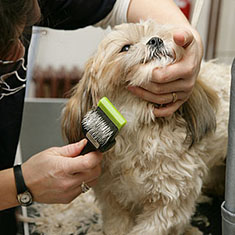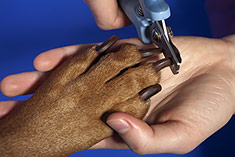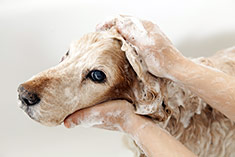Grooming Your Gorgeous Canine
We all know that you could spend a fortune on grooming your dog, but what grooming tasks are truly important and what ones are not really necessary? Like so many other questions, the answer is, “it depends”.
Brushing your dog

Most dogs will need to be brushed, at least occasionally, but there are several variables that determine how often – and how hard – it will be to complete the task. Your brushing requirements will be most impacted by the breed you choose, and for some people that’s the most important consideration when choosing a dog.
For example, a Yorkie, if kept in a show clip with the long, flowing hair, needs to be brushed daily, and it may take a fair amount of time. If you don’t plan on showing your Yorkie, you may opt for a “puppy cut” which makes brushing a snap. A Poodle may need a thorough brushing once a month, and a Beagle may need weekly brushing, but it only takes five minutes. For some dogs such as the Puli, brushing is totally inappropriate as the cords must be carefully formed after each bath.
Obviously, longer fur takes more brushing than shorter fur. The length and texture of the fur will determine not only the workload you will have to tackle, but also the tools you will use. For example, a pin brush or slicker brush is generally recommended for dogs with longer fur, while a curry brush or a bristle brush might be more appropriate for a short-haired dog.
For dogs whose fur gets a lot of mats, you might choose a de-matting rake, and for dogs who shed a great deal, you might want an undercoat rake to pull out all of the dead fur from underneath. For dogs who shed excessively, some families find it useful to get a rubberized glove that allows you to simply pet your dog and remove the loose fur. Dog Supplies Advisor can help you choose the right tools for your dog.
Even a dog who doesn’t shed much should be brushed regularly to remove loose dirt and to distribute oils from the skin down the hair shafts to the ends.
Trimming your dog’s toenails

For many dogs, a toenail trim is second only to a thunderstorm in the stress level it induces. Even if you work with your dog from the day he or she comes into your home, getting the animal used to you touching his or her feet, toenail trimming is still not a task for the faint-hearted. Here’s a secret: if you walk your dog regularly on a cement or blacktop surface, you may never have to trim the dog’s toenails! The friction between the nails and the cement will grind them down sufficiently.
If, for whatever reason, you need to do some trimming yourself, you’ll probably need to spend some quality time with your dog, calming him or her down enough to accomplish the task. It may help to do some heavy playing first so the dog is a little tired when you start. Keep plenty of treats close by and reward your dog for his or her patience as you go.
Have your dog lay on his or her side on a table or bed. Lean over the dog’s back so your body helps to anchor the animal in one place. With a firm grip, hold the dog’s paw and place the clippers over the end of the nail. Clip briskly at a 45-degree angle to remove the dead portion of the nail, being careful not to cut into the quick, a blood vessel that feeds the nail. If the nail bleeds, you have cut too deeply and will need to apply styptic or corn starch and gentle pressure to stop the bleeding.
Drs. Foster and Smith have a helpful video describing the quick and how to avoid it, but the dog used in the video is extremely compliant, which is often not the case with “real” dogs. In this Howcast video they demonstrate how to deal with a non-compliant dog, although the dog in the example is unrealistically easy-going.
Bathing Your Dog

News flash: if your dog finds anything that smells absolutely awful, he is going to roll around in it. While the odor may be disturbing to you, your dog will think he has found heaven on earth. Even if there are no dead animals near your home to roll in, your dog may occasionally come home smelling like something less than a rose. Or, the mud puddle from last night’s rain may just be too enticing to avoid.
In any case, your dog will need a bath sooner or later, so you should be prepared to provide one with the least amount of stress. Bathing ranks right up there with toenail clipping on the stress level for many dogs.
It helps if you have everything you will need close to the tub before you bring the dog into the bathroom. If you have a shower with a door rather than a curtain, you may want to consider simply taking the dog into the shower with you. The doors prevent escape, and you can get cleaned up at the same time, rather than having to shower after you bathe the dog in a tub.
Regardless of whether you use your shower, your bathtub, or a tub in the back yard, you will need a good dog shampoo. Drs. Foster and Smith can give you some ideas of the kinds available for different types of fur and medicated shampoos for various problems. The only other things you need for your dog’s bath are lots of towels and a good deal of patience. Oh, and the ever-elusive dog. It’s best if you lock the dog in the bathroom or inside the shower or tether the animal outside to prevent the soapy-dog escapes often shown in movies.
Bathing, brushing, and toenail clipping are the major grooming chores for every dog. Beyond that, your dog may need some special care, primarily determined by breed, such as ear hair plucking or tear-stain cleaning. You can learn more about your specific breed by consulting the breed guides on doggies.com.
Doggies Den: Latest Articles
 Homemade Thanksgiving Treats for Your Dog
Homemade Thanksgiving Treats for Your Dog
NUTRITION We all want to include our dogs in our holiday celebrations, but hopefully, you're aware that sharing table scraps with your dog isn't always the best idea.
 Keeping Your Dog Safe during the Summer Months
Keeping Your Dog Safe during the Summer Months
HEALTH Summer is coming on fast, so it’s time to plan how you will keep your dog safe and healthy through the lazy, carefree, warm days.
 Vaccination Time Again-Keeping Your Puppy Healthy
Vaccination Time Again-Keeping Your Puppy Healthy
DOG HEALTH So you have your new puppy picked out. There are quite a few shots, treatments and examinations that will keep the newest member of your family healthy.
 Canine Thanksgiving Feast
Canine Thanksgiving Feast
NUTRITION With the wide variety of food at Thanksgiving dinner, chances are you'll want to give your dog something special, too. If you're contemplating what to feed your dog for the holiday, here is a guide to a great Canine Thanksgiving Feast.
 Dog Walking Tips Every Owner Should Know
Dog Walking Tips Every Owner Should Know
DOG FUN Walking your dog is not only crucial to keeping him healthy and happy, it strengthens the bond between your canine friend and his caregiver. There are a lot of obstacles out there. Don’t forget these simple tips to keep your walk fun and safe in the outside world.
 The Benefits of Physiotherapy for your Dog
The Benefits of Physiotherapy for your Dog
HEALTH The same techniques that physiotherapists use to treat a variety of injuries and conditions in humans have been adapted to suit animals with great success. Family pets, show dogs, and working dogs can all benefit greatly from physiotherapy. Dogs whose activities involve a lot of agility are especially susceptible to the types of problems that physiotherapy can address.
 The Decision- Adding a Dog to Your Family
The Decision- Adding a Dog to Your Family
FIRST TIME OWNERSBringing a dog into your family is a decision where many people don’t realize it’s magnitude until after they have the dog. There are a number of things that you need to research before you decide to purchase a dog, and it starts right in your own home.
 Bringing Your Dog Into Your New Baby's Life
Bringing Your Dog Into Your New Baby's Life
HEALTH Many believe that a dog and a new baby cannot happily coexist, so therefore the dog has to go. This is not necessarily the case.  A new baby does not mean you have to abandon your dog.

Doggies Den:
Most Popular Articles

Dog Pregnancy Symptoms
HEALTHIf you suspect your dog might be pregnant, check out part one in this series on pregnant dogs, where we cover pregnant dog symptoms.

Dog Birth
HEALTHIn the third article of our dog pregnancy series, we look at the wonderful, but messy, process of bringing newborn puppies into the world.

Indoor Dog Potties
DOG PRODUCTSIt's been a long day at work. You were so busy, you didn't even take time to eat a sandwich, let alone run home to let your dog out. You're on your way home, knowing the poor dog is crossing his or her legs by now, when your car breaks down, delaying you even further. Can't somebody make this easier?

Your Dog’s Digestive System
PHYSIOLOGYEver wonder why your dog eats so fast? Or why he eats gross things? Or why he gets sick to his stomach? Or why his waste stinks so bad? Some of these things are normal, some are not.

Canine Respiratory System
BREATHINGThe basic function of your dog's respiratory system is to bring oxygen in to and remove carbon dioxide from the body. Knowing the symptoms of respiratory diseases can help you help your stay healthy.

Shelter Dog Adoption Tips for Success
ADOPTION Are you intimidated by the prospect of "rescuing" a dog from a shelter? One reason that you may be wary of adopting a dog from a shelter is not knowing how to choose. Adopting a dog from a shelter can be a rewarding process, if you're prepared to do a reasonable amount of research.

Canine Urinary Tract Infections
SYMPTOMS AND TREATMENTDoes your dog seem to be having trouble relieving his or her bladder? Learn how to recognize the signs of urinary tract infections and how to treat them before they spread.

What to do for Dog Diarrhea
SYMPTOMS AND REMEDIESIf you have dogs in your house for any length of time, you have likely experienced at least one bout of dog diarrhea. Beyond the pain in the tuckus involved in cleaning up the mess, you should know what causes diarrhea, and when it's important to see the vet.

What to do for a Dog Bite
DOG BEHAVIOR Getting bitten by a dog can be scary, and you may be tempted to run around in circles for a while, trying to figure out what to do. Here's our guide to help you manage the situation.

Top Ten Tips for Living with a Senior Dog
DOG HEALTH Bringing home a new puppy is so exciting, but it doesn’t take all that long for your exuberant puppy to grow into a senior dog who may have special needs. Here are the doggies.com top ten tips for taking care of your companion who has been with you through so much.
